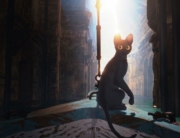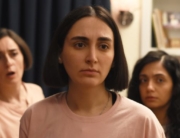The films of Godfrey Reggio have no dialogue, mainly because, to paraphrase the director, he believes that language is an artifact constructed thousands of years ago which does not describe our lives today. So he rejects it, and presumably awaits the arrival of something more adequate for the different ways we interact with our world.
His latest film, Visitors, is completely in keeping with this radical philosophy. It is a series of 74 Red Camera shots, filmed in color but later drained to black and white, held for varying lengths of time, and played out along an absolutely masterful, original Philip Glass score. The music, as is the case with many films featuring his work, is the best part of the film, and it would work perfectly well as a purely musical experience if you closed your eyes and just listened for the 87 minutes of its running time.
The first shot is, like most everything else in Visitors, a gorgeous composition, but it is also the most striking by far: a close-up of a gorilla that looks more pensive than any other gorilla imaginable (and maybe most people). It’s hard to believe it wasn’t some kind of CGI creation, but it isn’t—Reggio had to wait hours for the gorilla to focus on the camera, but when it finally happened, she stared directly into it intently for 20 minutes, resulting in a roughly 90-second opening shot where she reveals herself to be an alarmingly soulful, serious creature.
What Reggio is doing with this film is an attempt to revolutionize the medium itself. To walk briefly through the influential philosopher Walter Benjamin’s ideas on film, the experience of modern life is based in a nonstop series of shocks—we take in so many stimuli through our senses that we are forced to go through life in a kind of numbness just to make sense of it. This is the fundamental way that film, in contrast to painting, works. Watching a film, we cannot focus on a single aspect of it without that bit giving way to the next image. With a painting, we can focus on a single aspect and allow our minds to probe it for meaning in a free, associative way.
But the constant movement of images in film does not permit this kind of contemplation, which leaves us in a frenzied, shocked state. Visitors attempts to reverse these tendencies of the medium. Each of the 74 shots has plenty of space to breathe, and we are given as much time to chew on them as we need. The result leaves us more connected to our thoughts, senses, and selves, and is an attempt to make us register more of what we see by showing us less. Visitors is a bold hypothesis about what alternative combinations of image and sound might look like in some future where we have grown tired of the pace and structure of conventional narrative filmmaking.
Speaking of narrative filmmaking, the first thing we see, before the great gorilla shot, is the credit “Steven Soderbergh presents.” Soderbergh, one of the most successful Hollywood directors of the last 15 years, publicly made a big deal of his frustration with the industry, and recently announced a quasi-retirement from his A-list career. That this was one of the first projects he threw his clout (and money) behind shows how serious he was about his desire to do something radically different from, say, directing an Ocean’s 14. It successfully holds an audience’s attention without offering an ounce of what a viewer would expect—and that is an impressive accomplishment.
There are moments with enough of a critical edge to provide, oddly enough, some actual laughs. The funniest scene is a shot of a group of fans at a sports bar reacting maniacally to a game, filmed in the same elegant manner, set to the same inspiring score. The contrast between the high art of the composition with the gesticulations of the fans had most of the audience laughing. It’s the film’s most direct commentary on the absurdity of contemporary viewing habits, the baseness of being a “fan” of an entertainment product, and the best argument for a future of more films like Visitors, which challenge our assumptions of what a viewing experience should be. Before seeing it, make sure to enter as much of a meditative zone as possible, and be open to where the film takes you.







Leave A Comment